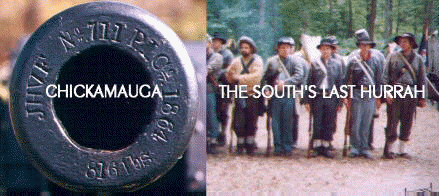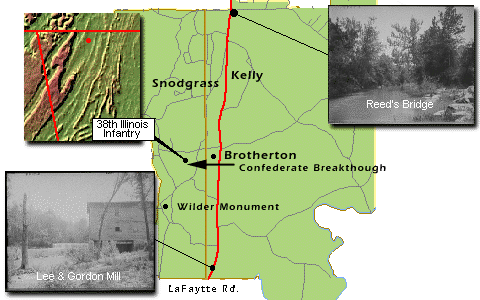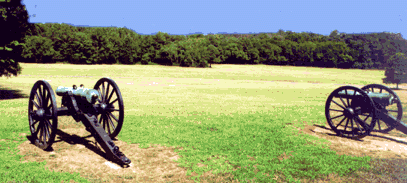

At approximately 11:30 A.M.. six Confederate divisions (23,000 men) moved through a gap created by General Rosecrans when he was given false information by a member of his staff. The alignment of brigades in Hindman's command was (from south to north) Manigault, Deas, and Anderson in reserve. On Deas' right was General Bushrod Johnson's division of Longstreet's corp. Within Deas' Brigade, the 19th Alabama was on the right flank (the northern most unit).Facing Deas' forces was the 2nd Brigade (XX Corp) under the command of Brig. General William Carlin. In Carlin's command consisted of the 22nd Indiana, 38th Illinois, 81st Indiana, and 101st Ohio. As described in Peter Cozzens's 'This Terrible Sound', 'Carlin's own skirmishers knew nothing of the Rebel approach until Deas' main line was on top of them. The Yankees bolted, the Confederates charged, and it was a race for the breastworks (Federal) among Carlin, his skirmishers, and the Alabamians.' After a short sharp fight, the Federals of this brigade not dead or wounded either took to the rear or surrendered.
From his position, General Rosecrans may have seen the 19th Alabama come out of the woods between the Brotherton field and the Tan Yard (right part of the picture). Once the Confederate entered the Tan Yard and the Dyer Field, General Rosecrans abandoned his position.

The 19th Alabama took 'friendly fire' while advancing across the Tan Yard Field toward what was to become known as Lytle Hill from the 15th Alabama (Sheffield's Brigade of Hood's Division). The 15th became disoriented as it exited the woods west of the Brotherton Field during the initial assault. As they entered the Tan Yard they came under Federal fire. Through the smoke they saw a body of troops and opened fire. These troops were the 19th Alabama. Upon being fired upon from the rear, Colonel Samuel McSpadden, 19th's commander, waved the 19th's colors in an attempt to show the 15th who they were firing upon. His efforts proved successful and the 15th moved to the right of the 19th for the assault upon Lytle Hill.

This is the point where 36th and 88th Illinois (Lytle's Brigade of Sheridan's Division of the XX Corp (McCook)) held the Federal lines along Lytle Hill. A soldier in the 36th Illinois wrote 'the ground was covered with dry grass and old logs which the bursting shells had set on fire. A thick cloud of smoke had risen about as high as our heads and seemed hanging like a funeral pall in the air. Under this we could see, away down the slope (view from this position) of the hill and across the little valley just as far as the eye could reach, moving masses of men hurrying toward us. In our front, not more than seventy or seventy-five yards distant, the enemy's front line lay secreted.' (Cozzens) The woods separating the Brotherton Field and the Tan Yard are in the background of this picture.Deas with assistance from Patton Anderson's Brigade, who had been ordered by Hindman to take a position between Deas and Manigault, assaulted Lytle Hill and drove the Federals from their lines. In the process, Federal Brigadier General William Lytle was mortally wounded and fell near a spot on the hill. That hill upon which Lytle fell now bears his name.
Now only a low area, (called the Bloody Pool) during the battle this was a small pond where men drank water that was contaminated with the bodies and blood of fallen men and horses. This marks the western most advance of the 19th. Alabama Beyond the trees are the hills of Missionary Ridge. These hills forced the fleeing Federals to move to the north and the left wing of the Federal army. Deas' Brigade begin a northward movement from this area as the Confederates began to drive the Federals northward toward Chattanooga and Snodgrass Hill
Snodgrass Cabin on Horseshoe Ridge - Around this cabin, Major General George Thomas became known as the 'Rock of Chickamauga' for his bulldog determination not to be driven by Longstreet's Confederates from what was then called Horseshoe Ridge.
After resting and resupplying, Deas' Brigade was ordered to attack the southwestern part of Horseshoe Ridge. The ridge was already under attack from other Confederate units and in fact was now becoming the focal point of the battle.
As Deas' Brigade assaulted the ridge it became entwined with Manigault's Brigade. 'The different regiments became mixed with each other, and here and there the faint-hearted were stealing to safer positions in the rear. Men fought from behind trees and coverts [sic] loading and firing while they dodged from point to point...In short, the character of the battle at this juncture was that of Skirmishing on a grand scale.' (Cozzens) The left wing of the Confederate assault on Horseshoe Ridge was going nowhere fast. The brigades of Deas and Manigault were worn down by the earlier fighting with the brigades of Lytle, Laiboldt, and Wilder. Three times Deas' Brigade charged up the slopes of Horseshoe Ridge only to be thrown down again. Holding this portion of Horseshoe Ridge was Mitchell's Brigade (98th Ohio, 113th Ohio, 121st Ohio, and 78th Illinois) of Steedman's division of the Granger's Reserve Corp. After the final charge, Deas' and Manigault's brigades were effectively out of the fight for the remainder of the battle. One regiment in Deas' Brigade, the 22nd Alabama, had suffered 250 casualties out of the 371 men who opened the attack just before noon that day. Deas' Brigade and the 19th Alabama had dislodged two Federal brigades, taken hundreds of prisoners and moved over three miles into the rear of the Federal line. It was no wonder that by early evening of that day, they were exhausted.

The Battle of Chickamauga was fought on two days (19-20) in September, 1863. This battle was the culmination of Major General William Rosecrans's Army of the Cumberland (57,000 )late summer (23 June - 20 September) 1863 campaign to maneuver General Braxton Bragg's Army of Tennessee (66,326 ) out of Tennessee. Fought in dense forests and small open fields in northwestern Georgia, Chickamauga was one of a very few clear cut victories for the Army of Tennessee. However, Bragg was slow to take advantage of the defeat of the Army of the Cumberland and the bulk of the Federal army made it safely into the lines at Chattanooga. It soon became apparent to many of the Confederate generals that a perfect chance to destroy an entire Federal army had slipped away. Never again would the proud Army of Tennessee have a chance as had existed in the woods along the banks of the Chickamauga.After his defeat at Chickamauga, Rosecrans was removed as commander of the Army of the Cumberland and replaced with George Thomas (the "Rock of Chickamauga"). Bragg laid siege to Chattanooga and Longstreet took his corp east to Knoxville to remove Burnsides from that east Tennessee city. Neither were successful in their efforts. Longstreet took his corp back to the Virginia theater after failing to defeat Burnsides. Bragg was routed from the hills around Chattanooga in a series of battles late November '63 by forces led by General U.S. Grant.
About 11 a.m. (20th) we were ordered forward. Scaling our breastworks, we advanced in good order, driving the enemy from the woods across the field some 50 to 75 yards from its further boundary, we were met by a volley of musketry from the enemy, who had been securely placed behind breastworks in the edge of another woods. At the first fire of the enemy, so unexpected and near, my regiment exhibited a momentary hesitancy and wavering, but upon my ordering 'charge,' it moved at double-quick, and, with a shout, scaled the enemy's works, and pursued their panic-stricken and shattered ranks through the woods and undergrowth until, reaching the borders of another open field, the enemy were discovered behind some houses, potash-works, and rail breastworks. At this point there was not even a temporary hesitancy, but with an increased shout and rapidity of step, we drove the enemy from these works with great slaughter, and pursued them through the open field some 250 yards to an elevated skirt of heavy open woods, where we again came upon him and drove him in utter confusion from two pieces of artillery and other breastworks. There being no horses near, we were compelled to leave the pieces of artillery on the ground. During the next morning, we were enabled to gather about 50 prisoners, two or three wagons of rations, ammunition, etc., with one piece of artillery and many small-arms. Colonel Samuel McSpadden's After Action Report - 19th Alabama Infantry
My regiment entered into battle with about 469 guns. My loss was: Killed 34; Wounded 158; Missing 12 (a causality rate of 44%). My regiment deeply mourns the loss of many gallant comrades, and especially of a good man, a consistent Christian, and excellent officer, in the person of First Lieut. Joseph B. High, Company H, who was in command of and fell while gallantly leading his company at the enemy's third breastworks (Horseshoe Ridge). While I cannot specify the many acts of gallantry exhibited by the different officers and men under my command, there was one instance of valor and daring so extraordinary as to demand my attention. On the second charge in the evening (Horseshoe Ridge), when the troops on my right gave way and my right wing began to waver, Captain Hugh L. Houston, Company B, sprang to the colors, and rushing with them to within 30 steps of the enemy's cannon, gallantly waved them and urged the men to follow their country's banner. But finding he was supported by only 40 or 50 men, they were compelled to retire, which they did in good order.
A letter home from Ambrose Doss (Company C, 19th Alabama Infantry)
Camp Near Chicamauga Tenn Sept 23 1863 "Dear Wife... I am well and come through the Battle Safe tho there was Several of the Boyes killed and wounded in our company, there was fore (four) killed James Robins Tom Bove John fortes Frank Warmick is thought be ded (dead) by this time...I havent no news to write only we whiped them badly and they fell back to chattanooga... A. Doss
Chickamauga was one of the bloodiest battle of the Civil War. Confederate losses totaled more than 18,000 out of some 66,000 engaged (27%). Federal losses were 16,000 out of some 58,000 (28%). On one day the 22nd Alabama Infantry Regiment (Deas' Brigade) lost 55% of its soldiers and almost half of its officers. "We advanced under a perfect shower of bullets," recalled Lt. Col. James Abernathy of the 8th Kansas Infantry (Heg's Brigade), "sometimes driving the enemy and in turn being driven by them, until we had fought over the ground over and over again, and almost half of our number lay dead and wounded." Confederate General William Bates, surveying the carnage, called Chickamauga a sluggish "River of Death." Cozzens writes in "This Terrible Sound," "no strangers to battlefield slaughter themselves, the French were nevertheless astounded by the carnage at Chickamauga. Said the Paris Figaro of the battle: "These Americans are fighting on a military system inaugurated by the Kilkenny cats. The two armies meet and fight and slaughter each other with the utmost fury. Then they fall back and reorganize for another general massacre. Positively, the war will end when the last man is killed".Cozzens finishes "This Terrible Sound" with a quote from General D.H. Hill, a Confederate division commander at Chickamauga. "There was no more splendid fighting in '61, when the flower of the Southern youth was in the field, than was displayed in those bloody days of September '63. But it seems to me that the elan of the Southern soldier was never seen after Chickamauga - that brilliant dash which had distinguished him was gone forever...He fought stoutly to the last, but, after Chickamauga, with the sullenness of despair and without the enthusiasm of hope. That 'barren victory' sealed the fate of the Southern Confederacy."
 (Back to Main Street)
(Back to Main Street)
